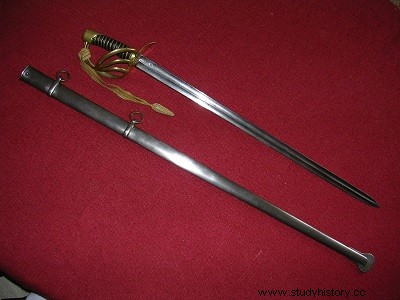
The slat is a single-edged sword or a saber without curvature, which amounts to the same thing. The first examples are contemporaneous with the first swords, then it experienced a period of oblivion or, at least, very anecdotal uses to finally come back in force at the end of the 17th century and until the end of the 19th century. It will then be presented as a long, uncurved cavalry saber to equip heavy cavalry regiments (the cuirassiers, among others) or the cavalry during the Napoleonic era in France (such as the horse grenadiers, the dragoons of the line, etc. .).
History
It was only used for a short time, hardly later than the appearance of the Merovingian sword and the Orientals (Indo-Persians then Arabs) used more practical curved weapons for their light cavalry whose aim was to mow down the infantry and not to drive the lines as the heavy cavalry equipped with swords does.
Superseded by the sword for heavy cavalry and by the curved saber for light cavalry, it was around the 8th century that this particular kind of saber fell into disuse, but it was used in the same way as n any other weapon for several more centuries. Latte was more Near Eastern than Western, with fighters from the latter region preferring double-edged weapons. This observation should however be put into perspective, since straight single-edged "Viking" swords have been found (probably a development of the langsax), the Middle Ages regularly saw the use of the falchion, and from the 16th century the possession of a Großes Messer was common for bourgeois in Germanic countries (as well as the falchion, the curvature and shape of the blades of these weapons varied greatly, but many straight-bladed examples are found), and that the " Scottish backsword, which is similar to the basket hilt but single-edged broadsword, had been in use since the 17th century. hilt with one or more branches in cast bronze or iron throughout the 17th and 18th centuries. The slat as such, with its blade with a single edge, almost symmetrical, wider at the heel than at the tip, comprising one or more gutters and with straight edges and backs, is quite typical in the 18th century and in Europe, moreover. It was from the Revolution and more particularly under the First Empire that the latte was able to express all the potential it represented on the battlefield. The cuirassiers, riflemen, dragoons and horse grenadiers were equipped with it and in their hands the lath proved to be a most effective weapon.
The perfectly straight shape of its blade was designed for thrusting (with the tip). On the other hand, if the slat is originally ill-suited to hit size, the slats of the French army and the Prussian army had a significant cutting capacity, something which is totally absent from the English slats for example.
The slat was the saber of the heavy cavalry until the Restoration, when it drifted towards another straight heavy cavalry saber, the 1822 model called "wobbly". From the reign of Napoleon III, it returned to service in the regiments of cuirassiers and dragoons with the 1854 model, then under the Third Republic with the 1882 model.
The Model 1882 saber would remain in service until these units were motorized in the mid-20th century.
